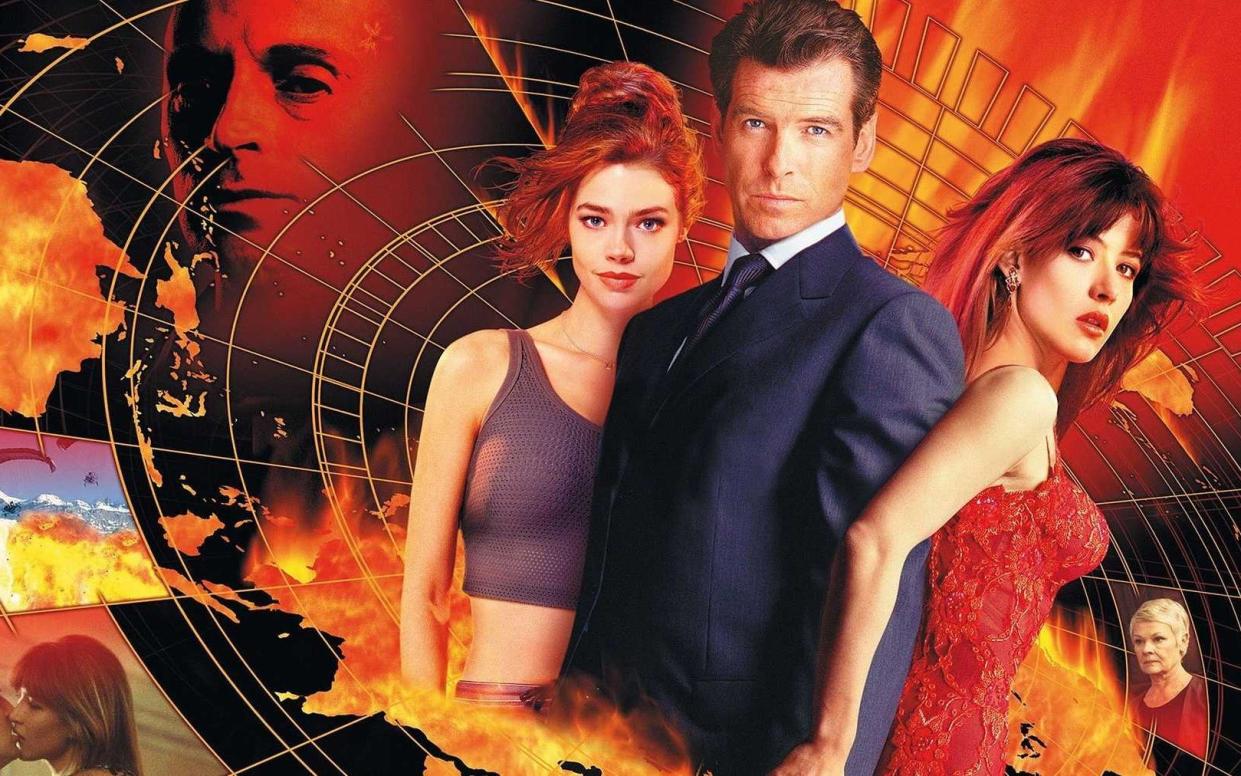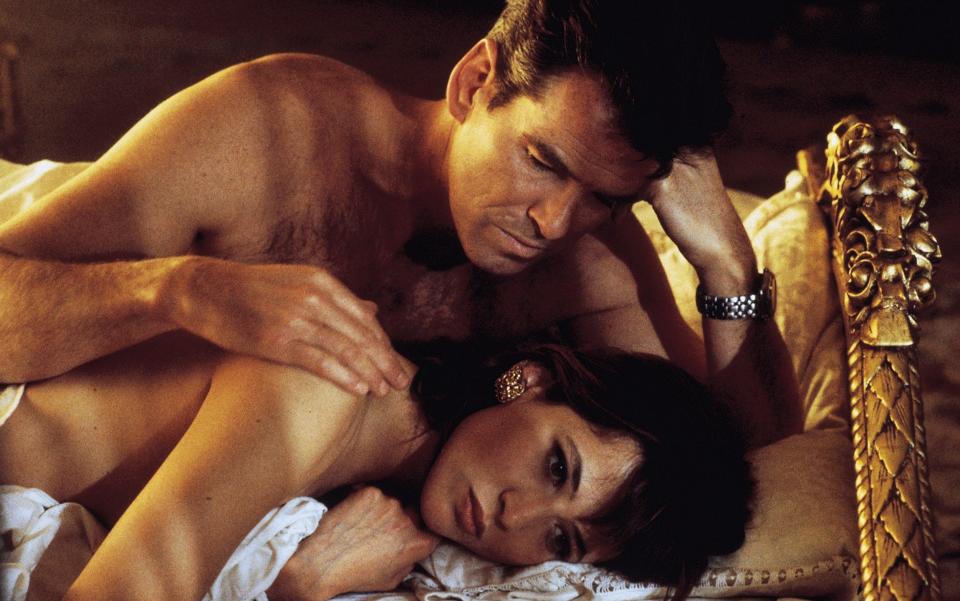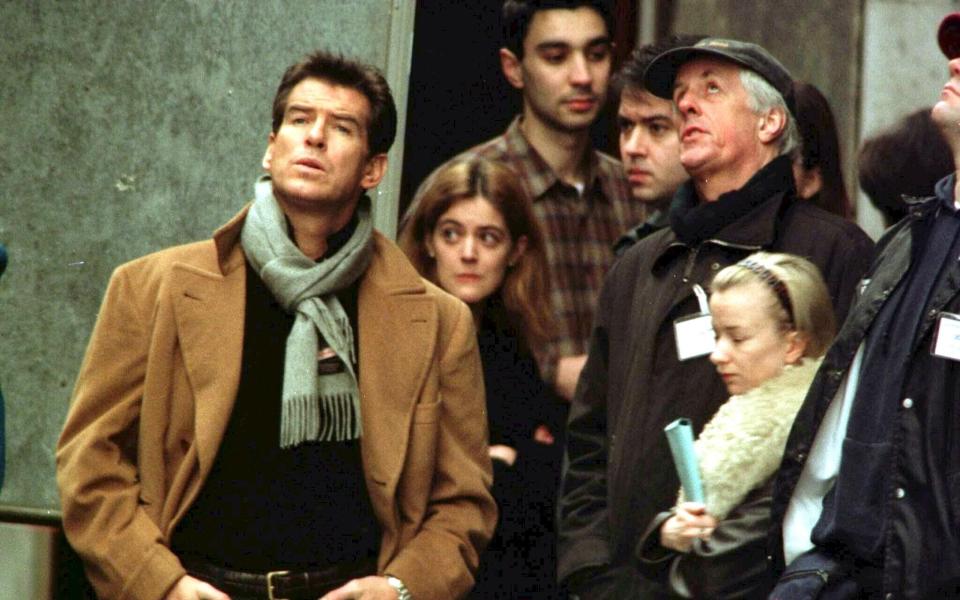The World is Not Enough: how Michael Apted wrenched Bond into a new, darker era

- Oops!Something went wrong.Please try again later.
- Oops!Something went wrong.Please try again later.
Michael Apted once admitted that he was “scared s---less” going into his 1999 Bond film, The World is Not Enough. And the director, who died last week aged 79, was an unlikely choice to take on 007. He was best known for directing the Up documentary series – a sociological experiment that followed the lives of 14 Brits, from kids to adults, every seven years – as well as low-key, serious-minded thrillers and dramas such as Nell, Blink and Gorillas in the Mist.
Bond, on the other hand, was pure blockbuster fodder, competing with the CGI-driven spectacles that had come to dominate cinemas in the Nineties. Apted’s previous film had cost just $6 million; The World is Not Enough would cost an estimated $135 million.
“When I was asked if I was interested, I thought it was a joke, because I had never done anything like it,” said Apted, being interviewed for Matthew Field and Ajay Chowdhury’s 2015 Bond retrospective, Some Kind of Hero. At his first meeting with the Bond producers, he told them, “I’m not an action director.” But the series’s longtime producer Michael G Wilson recalled replying, “‘Good, we didn’t want one.’ We wanted someone who was a good storyteller.”
Indeed, Apted relied on second-unit director Vic Armstrong and stunt coordinator Simon Crane to design and shoot the film’s big action set-piece: a speedboat chase on the Thames, which ends with Bond dangling from a hot-air balloon over the Millennium Dome.
It’s appropriate that Bond would see out the Cool Britannia era of the Nineties – during which 007 had become trendy and relevant again – on the newly-built Millennium Dome, that most celebratory of British monuments. The sequence would become overshadowed by other big set-pieces from Brosnan’s tenure – the dam-bungee and tank joy-riding antics of GoldenEye, or the CG-assisted farce of Die Another Day – but that arguably sums up The World is Not Enough: the unheralded gem of Brosnan’s tenure.
And not just for the action. Beneath the spectacle, Apted’s eye for realism made Brosnan’s Bond darker, deeper, more conflicted. As the director later said about being offered the job, the producers wanted “something a bit more dramatic than the others had been – they wanted to beef up the stuff between the action sequences.”
Other directors were considered for, or even offered, the director’s chair for The World is Not Enough, including Joe Dante, Martin Campbell, Alfonso Cuarón and Peter Jackson. It was, in hindsight, an interesting moment for the franchise: in 1995, GoldenEye had reinvented Bond with huge success, while in 1997, Tomorrow Never Dies was a formulaic step back.
Speaking on a behind-the-scenes featurette in 1999, Apted said he was from the generation that grew up on Bond – “None of us ever recovered from seeing Ursula Andress come out of the water” – but also admitted at a press junket that he wasn’t much of a Bond fan. In the Sixties, he was more likely to see a Fellini, Bergman or Godard film than the latest 007 adventure: “I came in ignorant not only of Bond films but action films.”
The World is Not Enough was the first in the series to be written by Neal Purvis and Robert Wade, the writers of every subsequent instalment. The story concerns Elektra King (Sophie Marceau), the daughter of a murdered oil tycoon; Renard (Robert Carlyle), a terrorist who feels no pain thanks to a bullet lodged in his brain; and a plot to control oil pipelines in former Soviet territory. It was inspired by a documentary that Barbara Broccoli saw about oil in Azerbaijan.

Apted also had an eye for the reality of it all. “I come from a documentary background, so in terms of the script I wanted things to be real,” he said in the 1999 featurette. “I wanted things to make sense, even though the film is really a fantasy.”
The film travels through plenty of Bond staples – a downhill ski chase, a trip to the casino, a race against the clock to defuse a bomb – but its ace card is Sophie Marceau as Elektra King, who’s a reversal of the classic Bond girl. In the story, she was previously kidnapped by terrorist Renard (Robert Carlyle); then, in the opening scenes, her father is blown up. M (Judi Dench) believes that Elektra’s life is also in danger, so sends Bond to protect her.
In the classic Bond formula, Elektra would be killed off or cast aside; instead, she reveals herself to be the film’s true villain. As Broccoli put it at the time: “Bond thinks he’s found Tracy [Bond’s murdered wife from On Her Majesty’s Secret Service], but really he’s found Blofeld.” Indeed, Renard is just a henchman.
Apted later realised that the producers also wanted him for his experience directing women. “The greatest social revolution of my lifetime has been the changing role of women in society,” he said at the Dubai Film Festival in 2013. “I’ve tried to avoid clichés. I’ve never allowed women to be ciphers or caricatures… I discovered it wasn’t some great epiphany they’d had [about offering him the job]. They just wanted to get more women in to see Bond films.”

Apted wanted to cast Marceau after seeing her in the 1997 romantic drama Firelight. He had to fight for her because she was expensive, unproven at the box office, and, well, French. Apted also brought his then-wife Dana Stevens onboard to rewrite Purvis and Wade’s script and strengthen the female characters. Looking at where Bond is now, they were ahead of the curve, but, as detailed in Some Kind of Hero, there was pushback. Michael Wilson scoffed at ideas for the Elektra character, and Brosnan didn’t like Stevens’s script. (“He felt he was being short-changed by it,” Apted said. Bruce Feirstein, writer of GoldenEye and Tomorrow Never Dies, was brought in to punch up Bond’s role.)
For Apted, prepping a major action movie was a daunting experience. “I was swamped in pre-production, because it’s a six-month shoot, and you have to be making decisions in November about what you were going to shoot next June,” he told Indiewire in 1999. “It was a bit bizarre. I found it overwhelming.”
Part of the difficulty was finding new visuals, locations or action set-pieces. “It’s hard to find new stuff, to not repeat what Bond’s done before,” Apted added. “Also, to compete with the other great action films that are out there.” But his documentarian instincts kicked in: he took the crew to a real oil operation in Azerbaijan. “I suppose my whole faith in documentaries is that the truth is stranger than fiction.”

Apted would get one further surprise during production, when Sean Connery appeared unannounced at the Pinewood Studios 007 Stage. As the director recalled it to Field and Chowdhury:
I heard this voice behind me say something quite ordinary. I thought “s---”, and I turned around, and it was Sean. I nearly passed out. I had no idea he was there. It was almost like a dream, in many ways. I’m talking to Pierce over the intercom and I’ve got Sean standing behind me, sat on my shoulder watching the monitor. It was thrilling and scary. I thought he was going to give me some notes.
Setting aside the cultural impact of GoldenEye, The World is Not Enough is the best film of the Brosnan era. Premiering on November 8 1999, it also went on to beat GoldenEye at the box office. Coincidentally, it opened in the US the same week as Apted’s 42 Up, the sixth installment of the Up documentary series. Apted remarked at the time that Up and Bond were the two “longest-running franchises in the history of their genres”. (As of his death, both had continued onto their ninth and imminent twenty-fifth instalments, respectively.)
The 1999 film is bolstered by some thrilling set-pieces. There’s the thunderous boat sequence, a downhill ski and snowmobile chase, and Bond’s BMW being sliced in half by a helicopter armed with a dangly buzzsaw. (“All of this is kind of intimidating to me,” Apted said about filming those scenes.)

Dench described Apted as “an actor’s director. No matter what he decides to do, there is flexibility for you.” It’s perhaps no surprise that The World is Not Enough also marks Brosnan’s finest performance as Bond; there’s a newfound edge – something seething beneath the ultra-smooth surface. In the opening scene, 007 is on a fiery mission of revenge – and he’s quite willing to kill a Swiss banker and his henchman if he doesn’t get answers; later, with a gun held to Renard’s head, Bond gives a rare glimpse into the darker recesses of both his psyche and profession. “I usually hate killing an unarmed man,” Bond tells Renard. “Cold-blooded murder is a filthy business… but in your case I feel nothing, just like you.”
In another moment, Elektra asks Bond if he’s ever lost anyone he loved – a reference to his murdered wife, Tracy – but Bond holds a steely gaze. Broccoli and Wilson told Apted, while discussing the scene, that “Bond never reveals himself”. But under Apted’s direction, he sort of does: Bond carries around the guilt of Elektra’s father being killed, and finds himself in the grip of a complex affair with her. It climaxes with a sexually-charged torture sequence, in which Elektra straps Bond to a chair and slowly strangles him. After escaping (naturally), Bond shoots her in cold blood.
Unfortunately, the passing of time has not been kind to Nineties Bond. The sexism and daftness seems even more jarring than in Seventies Bond, which may be due to its proximity. The World is Not Enough certainly isn’t free of 007 silliness. The boat chase takes a detour through a fish market, a scene that has Roger Moore written all over it, while numerous naff lines undercut the grit: “Would you like to check my figures?” asks a banker’s sultry assistant. “Oh, I’m sure they’re perfectly rounded,” Bond quips.

There’s also, of course, the painfully unfunny banter of John Cleese’s R – who would have better suited a Johnny English film – and Dr Christmas Jones, a nuclear physicist played by Denise Richards, among the most laughable characters in Bond history. (Not that a beautiful woman can’t be a nuclear physicist, of course, but let’s be honest: she was an excuse to make bad Christmas puns and watch her splash around a nuclear submarine in a wet T-shirt.)
Michael Apted was working within the parameters of what now feels like an outdated formula, with producers who were deeply protective of the Bond character. But in the film’s darker elements, there’s a sense that the director already knew where the franchise was going, years before the Daniel Craig era. Speaking in Dubai in 2013, Apted recalled his desire to bring more realism to the franchise: “I’d suggest something grittier and they’d say, ‘Bond wouldn’t do that.’ ‘Well, why not?’ ‘He wouldn’t.’
“They’d done 19 [films by that point], so I figured they knew better than I. But [Bond] does change – and that’s what has allowed it to be as successful as it is.”

